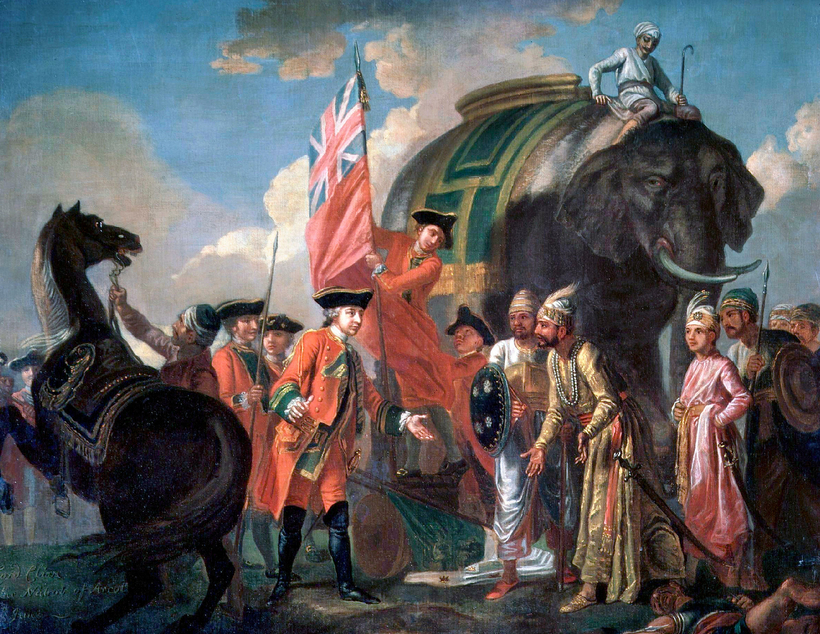Even the most twisted modern executive’s fantasies of corporate power cannot compare with the reality of the English East India Company. Difficulties with an intractable foreign government? Arm your employees, turn your offices into fortresses, and attack on the flimsiest pretext. Competition? Eliminate it by force or, better still, legislation backed by force. Corruption at the highest level? By all means!
The E.I.C.’s peculiar trajectory almost defies exaggeration. By what strange historical alchemy did homely Elizabethan opportunists become imperial overlords? Or, in pseudo-dramatic business-school-case-study-speak: “As Richard, Marquess Wellesley, swirled his triumphal brandy, surveying Delhi from the heights of the Red Fort, he wondered: How had benighted middle-class traders supplanted the Mughal Empire?” William Dalrymple’s The Anarchy makes sense of the E.I.C. and the political and economic conditions that enabled its curious ascent.
Driving Ambition
Like many successful ventures before and since, the E.I.C. was inspired by envy and greed—greed for the profits of the burgeoning spice trade and envy of those making them, principally Netherlander merchants who merged into the Dutch East India Company. As unoriginal as it was optimistic—previous English forays to Asian ports had been dismal failures—the E.I.C. was incorporated on December 31, 1600. Its charter document was an ominous mixture of precision and ambiguity. Committees and protocols were strictly defined; the far-flung markets over which E.I.C. hirelings were given exclusive rights were not. This was no accident. Their nominal goal was the East Indies, not India—and they knew little about either.
That the company appeared pathetically insignificant to the Mughals—peripatetic Central Asian descendants of Genghis Khan and Tamerlane, who ruled much of the subcontinent—was perhaps its greatest advantage. From 1615, when the courtier-emissary Sir Thomas Roe bore gifts to the Emperor Jahangir’s court, until the death of Jahangir’s grandson, Aurangzeb, in 1707, the E.I.C. shuffled along deferentially. In Aurangzeb’s wake, Mughal authority receded and, in one rueful official’s phrase, the “hat-wear[ing]” company men drank “the wine of arrogance.” As the next 150 years would prove, the taste was to their liking.
The E.I.C.’s peculiar trajectory almost defies exaggeration.
In lesser hands, the overlapping narratives of the ensuing, near-constant struggles between the Mughals and the Marathas, the Marathas amongst each other, and the E.I.C. against all comers—with famine (Bengal, 1770), an impeachment trial (Warren Hastings, 1788–1795), and the collateral effects of Anglo-French conflict (from the War of Austrian Succession to Waterloo) stirred in—would sink the reader. Dalrymple, however, navigates the teeming current of events smoothly, here gliding forward, there slowing to study the view.
From the crowded ranks of the E.I.C. and its foes, we observe: Job Charnock, founding Calcutta from the ashes of defeat; Robert Clive, the bloody-minded pioneer of the company’s lucrative military intriguing, whose brazen non-defense against allegations of embezzlement and bribery (in view of the riches within his grasp after the Battle of Plassey, “I stand astonished by my own moderation”) might serve as his epitaph; Hastings, the imperfect but unfairly maligned governor-general; Shah Alam II, the Job-like, would-be 18th-century Mughal sovereign; Tipu Sultan, the charismatic Hannibal of the close-run Anglo-Mysore Wars; and Richard Wellesley, elder brother of the future Duke of Wellington and an exceptionally ruthless, unapologetic exponent of serial conquest.
A hollowed-out Mughal state and savage internecine bloodletting provided the E.I.C.’s opening. Yet it was the combination of superior military technology, discipline, and tactics; access to capital; steady, extractive revenue streams; and an improbable run of luck that allowed the company, as Edmund Burke wrote, to begin “in commerce and [end] in Empire.” Monopolistic privileges awarded in earlier, uncertain times kept interlopers at bay; they also ensured that the E.I.C. remained an inflexible and unanswerable travesty of governance.
In lesser hands, the overlapping narratives of the struggles between the Mughals and the Marathas, the Marathas amongst each other, and the E.I.C. against all comers would sink the reader.
Dalrymple traces the contributing factors to the company’s transformation and ends somewhat abruptly at the turn of the 19th century, hastily summarizing the Sepoy Mutiny (1857–58), which brought E.I.C. control over India to an overdue close. An epilogue drawing shallow contemporary parallels to the “perils” of multi-national corporations strikes the only false note.
Why, throughout the E.I.C.’s history, were the better natures of the few no match for the self-interested, frequently bigoted evils of the many? Dalrymple condemns the “dangerously unregulated” nature of the enterprise and the “mechanism of a for-profit corporation, which existed entirely for the purpose of enriching its investors.” To these must be added the original sin of monopoly, which relieved the E.I.C. of the pressures of accountability and reform.
Max Carter is the head of the Impressionist and Modern Art department at Christie’s in New York


